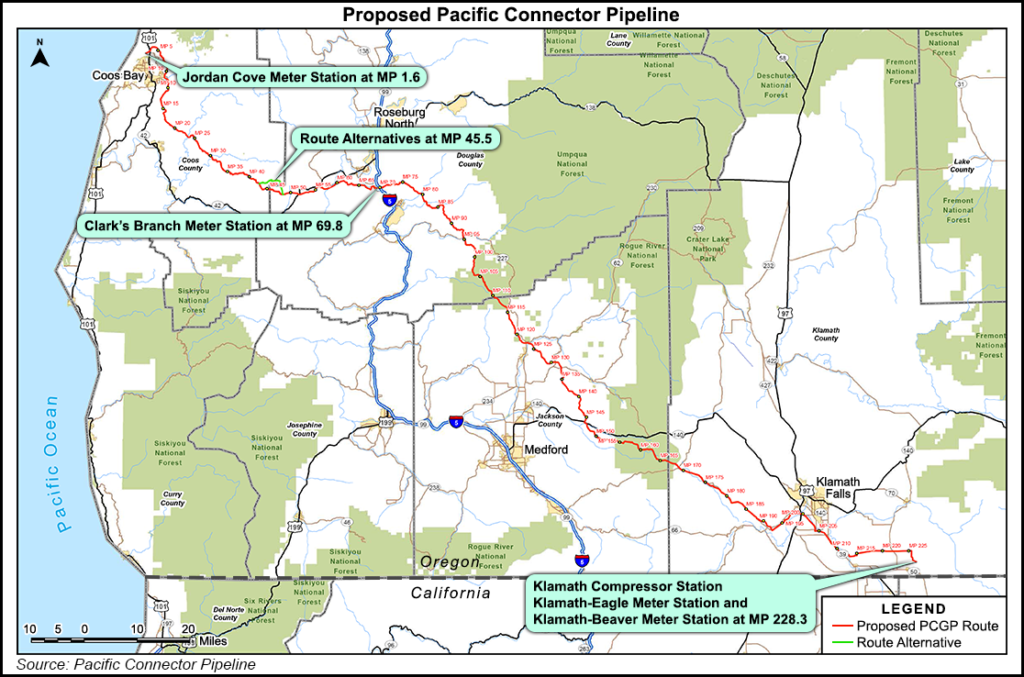Colorado Steps Up Lobbying for Jordan Cove LNG Project
With Oregon LNG’s Columbia River project now canceled, Colorado business and elected officials on Tuesday stepped up their support for the lone remaining West Coast liquefied natural gas (LNG) export project along the south-central coast of Oregon.

The Jordan Cove LNG project and 232-mile connecting transmission pipeline were the focus of meetings in Grand Junction, CO, pushing Piceance Basin gas supplies for the $7.5 billion, 1 Bcf/d project now attempting to get back on track with federal regulators in Washington, DC (see Daily GPI, April 11). Last month the project was rejected by FERC while leaving room for the rehearing request (see Daily GPI, March 14).
In the past week, West Slope Colorado producers, the state’s two U.S. senators and a congressional representative from the area have deluged the Federal Energy Regulatory Commission with letters urging the agency to quickly grant a rehearing and get the project back on the permitting track.
Sen. Michael Bennet (D-CO) said during the meeting in Grand Junction that LNG exports from the West Coast to Asian markets are “critical” to both Colorado and the United States as a whole. He cited a recent Grand Junction Economic Partnership white paper underscoring the economic viability of exports of western Colorado gas supplies to Asian markets. “It makes a strong case for why the Piceance is ripe for new, long-term investments,” Bennet said.
Bennet said he is working with other Colorado congressional members and senators from neighboring Wyoming and New Mexico to sponsor legislation to streamline the U.S. Department of Energy (DOE) export permitting process. “It will make sure the DOE acts quickly on these applications,” he said.
The West Slope chapter of the Colorado Oil & Gas Association (COGA) members have told FERC that Jordan Cove is “the most important energy infrastructure project west of the Continental Divide,” said David Ludlam, executive director of COGA’s west slope group.
“Western Colorado’s gas industry is a diverse bunch of people with unique business models and divergent opinions, but on this project, the producing members are 100% united,” said Ludlam, who characterized the Oregon LNG export project as “a major economic and geopolitical opportunity” for the nation.
Tuesday’s meeting at the Colorado Mesa University’s Unconventional Energy Center stressed the Piceance in northwestern Colorado as “one of the most reliable, exciting and geographically advantageous” resource supplies in the nation with access to the Pacific Northwest already in place through the Ruby Pipeline.
Jordan Cove’s proposed Pacific Connector 36-inch diameter gas transmission pipeline is designed to meet with Ruby and other north-south interstate gas pipelines in southern Oregon near the California border at Malin, OR.
The white paper by the local economic partnership “demonstrated the economic development potential for northwest Colorado that may result from West Coast energy exports, specifically examining Jordan Cove and Pacific Connector,” Ludlam said.
Plagued by sustained local opposition, backers of Oregon LNG, a proposed liquefied natural gas (LNG) export project along the mouth of the Columbia River, this week pulled the plug on the decade-old project to build a liquefaction terminal and connecting 87-mile gas transmission pipeline (see Daily GPI,April 18). Local officials in the port town of Warrenton, OR, where it was to be built, and the larger Clatsop County over which a portion of the transmission pipeline was routed, never got behind the $6 billion project being backed by New York City-based conglomerate Leucadia National Corp.
© 2024 Natural Gas Intelligence. All rights reserved.
ISSN © 1532-1231 | ISSN © 2577-9877 |
